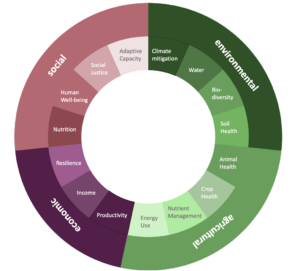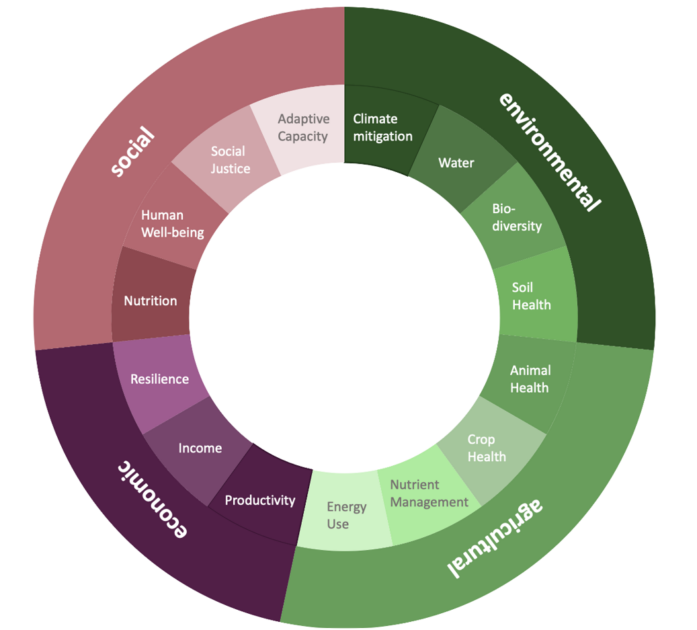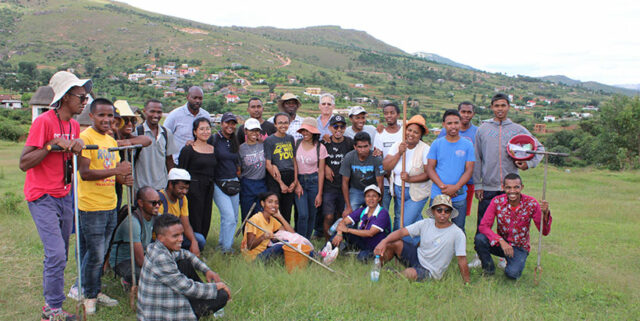
Authors of this blog post: Chaturangi Wickramaratne (IWMI), Sarah Jones (Alliance Bioversity-CIAT), Christine Lamanna (CIFOR-ICRAF) and Matthias Geck (CIFOR-ICRAF)
The need for a paradigm shift in agriculture is becoming increasingly evident. High-input, simplified or intensive agricultural farms and landscapes fail to achieve food and nutritional security or provide resilience to global shocks, such as climate change. At the same time, they are root drivers of environmental degradation and many social and economic ills. Interconnected systems of land, forest, soil, and water are stretched to the limits by human-induced climate change, biodiversity loss, pollution and overexploitation, which, collectively, reduce the productive capacity of agricultural landscapes[1] and threaten the existence of all life on earth. Farms and food systems need to shift from degrading to restoring ecosystems, while supporting the world’s 570 million farm owners and their communities to achieve healthy and socially just quality of life and financially secure livelihoods.[2],[3]
Agroecology (AE) is increasingly recognized as a holistic approach to transforming food systems sustainably by capitalizing on local knowledge, enhancing social capital, and maintaining ecological integrity. AE “applies ecological principles to agriculture and ensures a regenerative use of natural resources and ecosystem services while also addressing the need for socially equitable food systems within which people can exercise choice over what they eat and how and where it is produced.”[4] AE is further considered to be a science, a movement and a practice used to transform the food system as a whole, consisting of a network of food production, distribution, and consumption.[5],[6]

With a growing interest in AE globally, there is also an increased need to evaluate the performance of AE across different scales and contexts. Holistic assessment frameworks are required to determine the agronomic, economic, environmental, and social performance of farming systems at different stages of transition toward AE. The results from such assessment frameworks can be used to identify when agroecological practices are effective at meeting multiple locally or globally important outcomes, and when trade-offs arise between development objectives. Establishing these evidence banks provides a valuable resource to catalyze investment in agroecology by both private and public sector actors to transform food systems to meet production, environmental and social goals in tandem.
A key objective of the CGIAR Agroecology Initiative is to develop a holistic assessment framework that generates evidence on the performance of food systems across various dimensions and scales of agroecological transition. Although many tools have been developed to assess the sustainability of agricultural systems, most do not comprehensively represent environmental, social, and economic aspects of sustainability, nor use indicators that are sensitive to agroecological principles. Assessment frameworks also struggle to balance the trade-off between capturing standardized, globally comparable metrics or capturing metrics that are locally relevant and context-specific.[7] These factors make it challenging to assess the multi-functional and multidimensional performance of AE across food systems in diverse contexts.[8],[9] This is particularly true for frameworks developed in the Global North, which may not be applicable to the conditions present in the Global South.[10] Therefore, there is a critical need for an AE-specific assessment framework that not only integrates key features of AE, but also encompasses the salient features of local AE endeavors.
A notable exception to several of the challenges mentioned above is the Tool for Agroecology Performance Evaluation (TAPE).[11] TAPE was designed to provide an analytical framework for collecting evidence on the environmental, social, economic, health and nutrition, as well as governance aspects of sustainability – at multiple scales and in varying locations and timeframes. While TAPE provides a strong foundation for our work, it relies on a relatively small set of performance indicators linked to the Sustainable Development Goals (SDGs), which are not necessarily aligned with local sustainability objectives and performance areas that are of high priority for our project, such as farmers’ agency, resilience to shocks, reliance on debt, and individual perceptions of well-being.[12],[13]
To meet the challenges of monitoring for agroecology, the Agroecology Initiative will develop a holistic assessment framework that consists of two parts:
- A set of globally relevant key performance indicators (KPIs) that capture economic, environmental, and social outcomes from implementation of agroecology and can be measured in any food system
- An indicator localization process that lets food system actors co-design and prioritize metrics of agroecological performance that are relevant and meaningful to their local context.
To develop a set of KPIs for agroecology, we first reviewed widely used agricultural assessment instruments and indicator frameworks (e.g., TAPE, MESMIS, Global Farm Metric, SDG indicators, CoSAI principles, Agrobiodiversity Index, and Science-Based Target Network among others). This generated a long-list of over 100 possible performance indicators relevant to AE. We then evaluated these indicators against a set of clearly defined criteria – primarily reflecting measurability, relevance, scientific robustness, and feasibility – to produce a refined list of 69 feasible indicators. The indicators were subsequently categorized under 16 themes (Fig. 1) and at least one KPI from each theme has been selected through a series of workshops with over 40 researchers. KPIs represent some of the most important measures for that theme and are feasible for collection by non-experts with limited training and are relevant across diverse farming contexts.

One of the key features of AE that separates it from other approaches is that AE is based on bottom-up processes that deliver localized solutions. Using available tools “off the shelf” without a co-design process can result in data that is not meaningful to the project and community objectives.[14] It is therefore vital that the assessment framework includes a co-design process where the concepts, indicators, and scales can be adapted to suit the local needs based on local stakeholders’ input. Consequently, the assessment framework will include a distinct localization process, so that the framework can be adapted to environmental, social, and economic conditions of the farming systems at various scales, reflecting the interests and aspirations of stakeholders involved.
The localization process will be primarily based on a participatory approach with stakeholders in the Agroecology Living Landscapes (ALLs) of the Initiative. Stakeholders will go through a process where they collectively envision what they want their community, landscape, and livelihoods to be, and then walk backwards to identify the steps they can take to reach that vision, using agroecological principles. Following this visioning exercise, the localization process asks stakeholders “How will we know if we’re getting there?”; i.e. what are some of the key indicators of success – or change – in the specific context of the ALL? Participating stakeholders will be guided through a five-step process where they 1) review the vision for their ALL, 2) brainstorm indicators of success, 3) identify selection criteria for indicators, 4) evaluate the long-list of indicators, and 5) prioritize key locally relevant indicators that will be collected in the ALL throughout the initiative.
Together, the global KPIs and locally selected indicators will form a localized agroecological assessment tool that can be implemented across diverse farming contexts and agroecological activities, from developing organic farming to increasing farmer agency in value chains. The evidence generated from this tool will enable communities to see the impact of agroecology on the things that matter most to them, while at the same time allowing decision-makers, investors, and other actors to see the impact of agroecology across contexts.
References
[1] FAO. 2021. The state of the world’s land and water resources for food and agriculture – Systems at breaking point. Synthesis report 2021. Rome. https://doi.org/10.4060/cb7654en
[2] Díaz, S., Demissew, S., Carabias, J., Joly, C., Lonsdale, M., Ash, N., Larigauderie, A., Adhikari, J.R., Arico, S., Báldi, A. and Bartuska, A., 2015. The IPBES Conceptual Framework—connecting nature and people. Current opinion in environmental sustainability, 14, pp.1-16.
[3] Lowder, S.K., Skoet, J. and Raney, T., 2016. The number, size, and distribution of farms, smallholder farms, and family farms worldwide. World Development, 87, pp.16-29.
[4] HLPE. 2019. Agroecological and other innovative approaches for sustainable agriculture and food systems that enhance food security and nutrition. A report by the High Level Panel of Experts on Food Security and Nutrition of the Committee on World Food Security, Rome.
[5] Wezel, A., Bellon, S., Doré, T., Francis, C., Vallod, D., and David, C. 2009. Agroecology as a science, a movement and a practice. A review. Agron. Sust. Dev. 29, 503–515. doi: 10.1051/agro/2009004
[6] Jones, S.K., Bergamini, N., Beggi, F., Lesueur, D., Vinceti, B., Bailey, A., DeClerck, F.A., Estrada-Carmona, N., Fadda, C., Hainzelin, E.M. and Hunter, D., 2022. Research strategies to catalyze agroecological transitions in low-and middle-income countries. Sustainability Science, 17(6), pp.2557-2577.
[7] Rosenstock TS, C Lamanna, S Chesterman, J Hammond, S Kadiyala, E Luedeling, K Shepherd, B DeRenzi and MT van Wijk. 2017. When less is more: innovations for tracking progress towards global targets. Current Opinion in Environmental Sustainability 26-27: 54-61. https://doi.org/10.1016/j.cosust.2017.02.010
[8] Bonisoli, L., Galdeano-Gómez, E. and Piedra-Muñoz, L., 2018. Deconstructing criteria and assessment tools to build agri-sustainability indicators and support farmers’ decision-making process. Journal of Cleaner Production, 182, pp.1080-1094.
[9] Wiget, M., A. Muller, and A. Hilbeck. 2020. Main challenges and key features of indicator-based agroecological assessment frameworks in the context of international cooperation. Ecology and Society 25(3):25. https://doi.org/10.5751/ES-11774-250325
[10] -do-
[11] Mottet, A., Bicksler, A., Lucantoni, D., De Rosa, F., Scherf, B., Scopel, E., López-Ridaura, S., Gemmil-Herren, B., Bezner Kerr, R., Sourisseau, J.M. and Petersen, P., 2020. Assessing transitions to sustainable agricultural and food systems: a tool for agroecology performance evaluation (TAPE). Frontiers in Sustainable Food Systems, 4, p.579154.
[12] Namirembe, S., Mhango, W., Njoroge, R., Tchuwa, F., Wellard, K. and Coe, R., 2022. Grounding a global tool—Principles and practice for agroecological assessments inspired by TAPE. Elem Sci Anth, 10(1), p.00022.
[13] Anthonioz, A. 2021. The suitability of the “Tool for Agroecological Performance Evaluation (TAPE)” in a European context. Ås, Norway: Norwegian University of Life Sciences.
[14] Namirembe, S., Mhango, W., Njoroge, R., Tchuwa, F., Wellard, K. and Coe, R., 2022. Grounding a global tool—Principles and practice for agroecological assessments inspired by TAPE. Elem Sci Anth, 10(1), p.00022.



